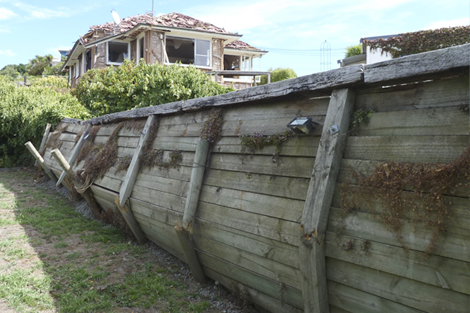Slopes and retaining walls
Slopes and retaining walls can crack, move or even collapse, particularly if they’re affected by pressure from heavy rainfall, earthquakes or other natural disasters.
Check your slopes
If you have a sloping property, make sure you know how the slope and surrounding buildings and structures might be affected in the event of heavy rain, storms, earthquakes or other natural hazards.
Some higher risk areas are where:
- surface material is soft or loose and easily dislodged, particularly where uncompacted loose fill has been used to level a slope and the fill isn’t held in place with an adequate retaining wall
- the slope consists mostly of soil and is more than 35 degrees (steep to walk up)
- the slope has been altered or cut into, making it more than 35 degrees, and plants that held the land firm have been removed
- landslides have occurred in the past (if you don’t know, ask neighbours or the local council)
- underlying rock has weathered, fractured or shattered.
If you have concerns about the stability of a slope or want to make some changes, talk to your local council or a qualified engineer.
Some signs that might indicate a problem with slopes
Keep a look out on your property for:
- unusually angled retaining walls
- small slips or rock falls
- subsidence or bulges on or at the bottom of the slope
- tilting trees or fences
- cracks in the ground, retaining walls, driveways, footpaths or other hard surfaces
- ground that’s become waterlogged
- water seepage at the bottom of the slope.
Look at neighbouring properties and roads immediately adjacent to the property, especially those immediately above the property, for these signs as well.
Consider any changes to buildings and structures on the property that might indicate land movement, including:
- doors or windows no longer closing easily
- uneven floors
- outside features, such as steps pulling away from the building, or diagonal cracks in plaster, brickwork, solid walls or foundations.
Maintain your retaining walls
Some retaining walls play a minor role as part of the landscape, while others support or protect your land, home or outbuildings. They may also support a neighbouring property. Check that retaining walls on your property are well constructed and maintained.
Your local council may hold information on the construction of any retaining walls on your property file. Older walls may have been built before there were Building Code requirements or weakened over time.
Look for construction issues such as narrow, tall poles that are spaced far apart and not secured with anchor bolts.
If you have any concerns or need work done, talk to a licensed building practitioner(external link) or engineer. It’s worth putting money aside for maintenance and repairs. If a retaining wall fails it may damage land, buildings or structures above or below.
Check your retaining walls
Monitoring and maintaining your retaining walls is important to reduce the risk of a slip, or the wall failing as a result of heavy rain, flooding or an earthquake. Watch for signs that may indicate wall movement, including:
- cracks in the wall
- the wall being on more of an angle than usual or expected
- roots penetrating or pushing the wall.
Watch out for signs that water is building up, including:
- any bowing or bulging
- poor or blocked surface drainage at the top of the wall
- clogged or insufficient drainage holes (weepholes) if it’s a solid wall.
Improving your retaining walls
If you want to improve an existing retaining wall, consider getting engineering advice. Work to improve a retaining wall may include:
- ensuring water can flow freely from top to bottom so that soil behind the wall does not become saturated and heavy
- inserting plants onto slopes to bind the soil with the roots to protect the stability of the soil
- adding anchor bolts to the wall
- cutting slopes to reduce the height of the retaining wall (this may even eliminate the need for the wall)
- building a new wall in front of an existing one if it is below standard or distressed.
Talk to your local council about what you need to do to meet Building Code requirements and whether you need a building consent before making any changes. You may also need an engineer’s report.
What if a retaining wall fails?
It’s worth thinking about what would happen if a retaining wall failed. Consider who and what would be affected. How would you pay for repairs? The work may cost more than you might receive from natural hazards cover or your private insurance cover.
Talk with your neighbours. If the retaining wall is on the boundary or outside your property, and it protects or supports your land, someone else may be responsible for making a claim if it fails in the event of a natural disaster. If it’s on an uninsured property, there won’t be any insurance cover.
Information about ownership of a retaining wall may be on the title or held by your local council. If you need to make a claim for damage caused by rainfall or a natural disaster, talk to your claim manager (either with NHC Toka Tū Ake or your private insurer).

Damage to a retaining wall following the 2011 Christchurch earthquake
External information
Types of retaining walls
You'll find information about different types of retaining walls on BRANZ's Build Magazine website.
Retaining wall regulations
Smaller retaining walls may not need consent but must meet Building Code requirements, as explained on MBIE's building website.
Talk to your council
Ask your council for information about existing or new retaining walls. You can find their contact details on the Local Councils website.